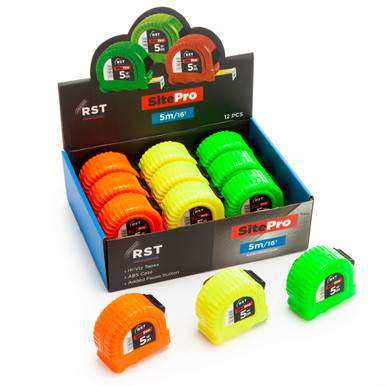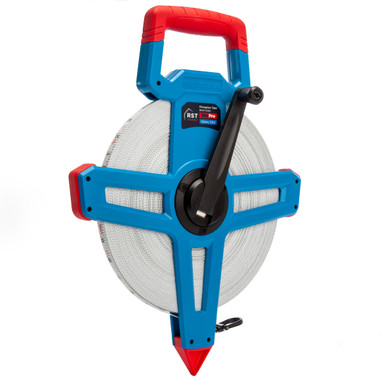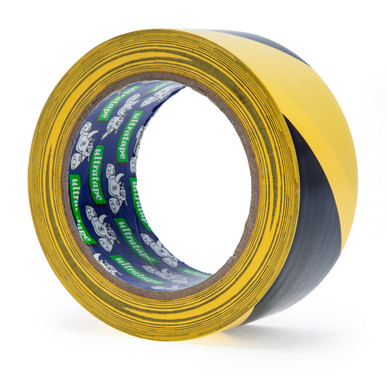How to use a Tape Measure
Posted by Katy | Toolstop on 6th Aug 2024
Tape measures are an essential measuring tool for the home and trade. This guide explains how to use and read a tape measure
What is a Tape Measure?
A tape measure, or measuring tape is a type of hand tool typically used to measure distance or size. It is like a much longer flexible ruler consisting of a case, thumb lock, blade/tape, hook, and sometimes a belt clip.
A tape measure will have imperial readings, metric readings or both. They are a common measuring tool used in both professional trades and simply around the home.
In this Toolstop guide, we'll explain everything you need to know about the tape measure. If you are after a new tape, you can shop the range.
Parts of a Measuring Tape
As explained above, there are many parts to a tape measure, all of which serve an important purpose. We have highlighted them and their function below.
Case
The case is where the tape/blade is housed. This often determines how durable the tape is as a whole. Some tape measure houses are made from metal, some from plastic and others from robust rubber which has been drop tested to withstand the impacts of the job site.
Case Length
On the back of the measuring tape, you will find the case length. It is essentially the length of the case, but is a great addition to your tape. It comes in handy when you want to measure round corners. Use the housing for inside measurements instead of bending the tape.
Thumb Lock
The thumb lock is designed to keep your tape in place at your desired length. It stops your tape from automatically retracting back into its housing when carrying out measurements. Simply release the thumb lock to put the tape measure back in its case.
Blade/Tape
The most important part of your tape measure, the blade (or metallic ribbon) is what gives you your accurate measurements. Imperial units are usually on the top row and metric measured markings on the bottom. More on the tape itself later...
Hook
The hook, located at the end of the tape comes in handy when measuring hard surfaces such as tables. You may notice that the hook is loose; this is intentional to ensure accuracy. If the hook has a hole in it, this is so it can grip onto screws.
Belt Clip
Does what it says on the tin. The belt clip simply allows the measuring tape to be hooked onto your belt so you can always have it to hand.
How to Read a Tape Measure
To ensure the precision of your projects, follow our tips and tricks below. The motto to live by is 'measure twice, cut once'.
Metric measurements on a measuring tape are displayed in Millimeters, Centimeters and Meters whereas Imperial measurements are in Feet, Inches and fractions of Inches. Metric readings are most commonly used in the UK, however this is purely down to personal preference. Imperial measurements are usually found in red on the top of the blade, whilst metric measurements are in black on the bottom.
Imperial
- On a standard tape measure, the biggest marking is the inch mark. It is written as a large number sitting to the left of the line. So 1=1".
- The foot measurement shows up on the 12th inch and is written as 1F
- 1/2" is the second largest line
- 1/4" is the third longest/shortest line
- 1/8" is the second shortest line
- 1/16" is the shortest line on the imperial measurement and indicates a 16th of an inch
Metric
- The 1 meter marking is located at the 100th centimeter and is indicated by 1m
- The centimetre is the longest line on the metric side of the blade and is indicated by a large number. It is found at every 10th millimeter marking. 1=1cm
- The millimetre is the smallest metric measurement on the blade indicated by the smallest line rather than a number or fraction. Every fifth millimeter line is slightly longer to indicate the halfway point between centimeters.
What is the Black Diamond?
You may have noticed that there are black diamonds on the tape. These are stud and joist marks. Although they don't appear on all tape measures, they are a great addition to those that they do. The stud marks appear at 16” intervals whilst the joist marks appear at 19 3/16” intervals.
The black diamond joist marks are designed for spacing I-beam timbers.
Every 16 inches, you may see a double arrow or a number marked in red. This helps you to locate every stud running across the wall once you’ve located the first one without needing to use a stud finder.
Did you know that the first inch on a tape measure is actually short by 1/16 of an inch? This is why the end hook is loose, as it measures exactly 1/16 of an inch to provide accurate results.
How to Use a Tape Measure
One you know how to read a tape measure, using one is actually pretty simple.
- Catch the hook or press it into one side of the object you're measuring
- Stretch your tape across your project until you reach your desired length/measurement. Try to keep the tape as straight as possible when doing so
- Lock the tape in place using the thumb lock so it doesn't retract
- Take your reading and either mark it out or write it down
When measuring, the edge of the object may fall between two lines on the blade. To avoid cutting too short, always round up to the larger measurement.
The lock function on a measuring tape is great for quickly seeing whether something will fit through a certain space or for keeping the obtained reading for making multiple measurements.
How to Choose a Measuring Tape
There are so many types of tape measure available on the market today, so which should you choose for the job?
Essentially, all tape measures do the same thing. Their job is to measure. What it comes down to is the applications you will be using it for.
If your tape measure if for simple measurements around the home e.g. to measure furniture, a tape measure with a plastic case will suffice. Our top choice for measuring tape for domestic use is the Irwin 10507788.
It features both metric and imperial readings on a sturdy 19mm wide tape and can achieve a 1.8 metre standout.
However, this is not the best option for the job site. If dropped from a height (a common occurence on site), the plastic case could crack. In this instance, it may be better for you to opt for a metal case or one with a rubberised body to absorb shocks. We love the Stanley FMHT0-36326 for this reason.
This model is the most ergonomic, long lasting FatMax tape measure ever. It has a huge 3.35 metre standout and features a Blade Armor coating which extends the blade life up to 10 times longer than a basic Stanley tape measure.
You can refer to our exclusive Stanley tape measure video to see our top picks, the differences of each and which is best suited to each use.
When choosing a tape measure for professional use, look out for features like a larger standout (the distance a tape can be extended before it bends), protective blade coating and robust housing. A protective coating prolongs the life of your blade during frequent use. Longer tape lengths are needed for larger scale jobs.
That was our complete guide to tape measures. You should now be able to identify the main parts of a tape measure, how to use and read one correctly and how to choose the best one for your application. If you have any other questions, be sure to get in touch!









